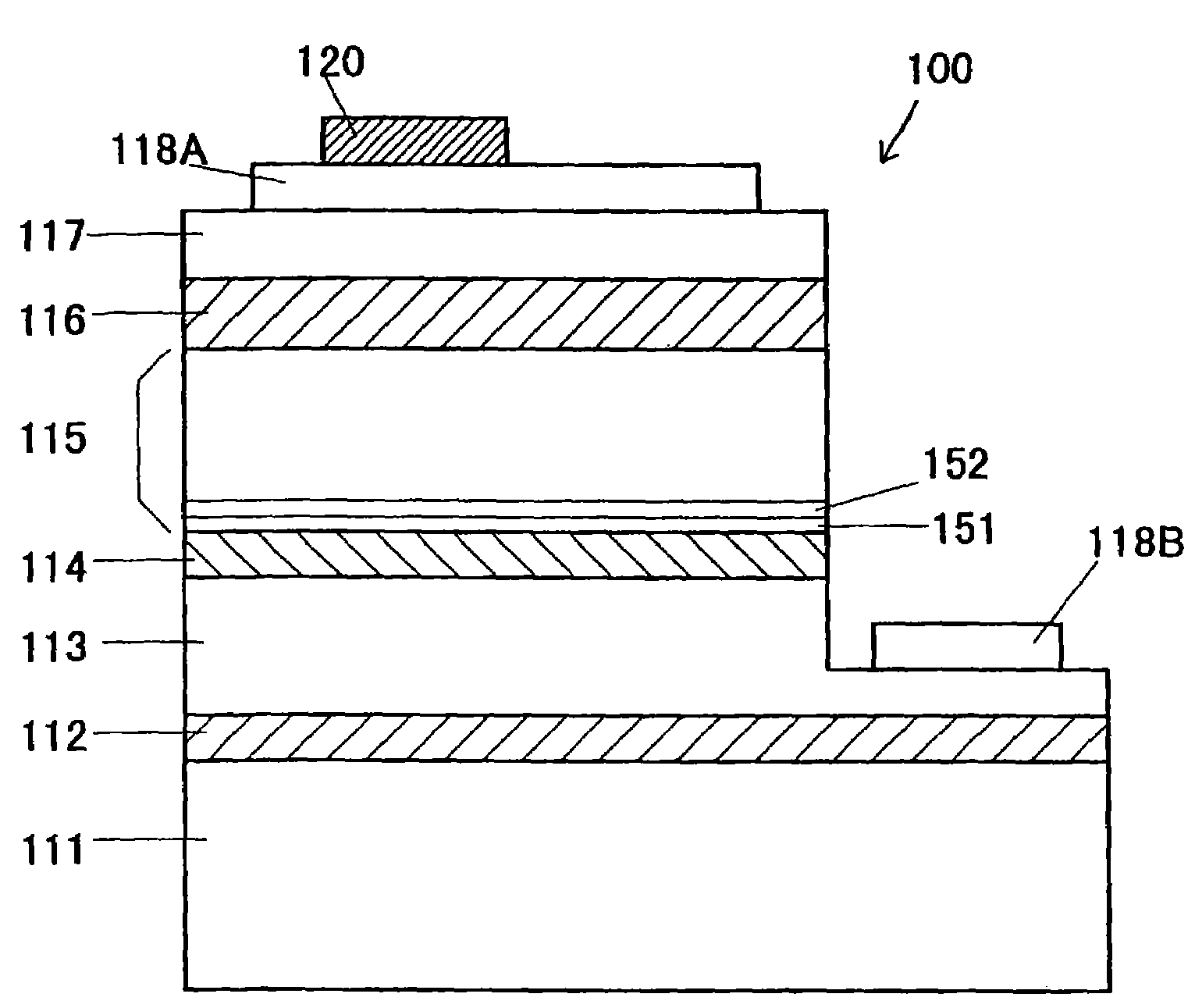Light-emitting semiconductor device using gallium nitride compound semiconductor
a technology of compound semiconductors and light-emitting devices, which is applied in the direction of semiconductor devices, electrical devices, nanotechnology, etc., can solve the problems of insufficient optimization of the conditions for emitted light, insufficient luminous efficiency, and persisting problems, so as to improve the luminous efficiency of the light-emitting device
- Summary
- Abstract
- Description
- Claims
- Application Information
AI Technical Summary
Benefits of technology
Problems solved by technology
Method used
Image
Examples
first embodiment
[0044](First Embodiment)
[0045]FIG. 1 illustrates a sectional view of a light-emitting device 100 using gallium nitride (GaN) compound semiconductor formed on a sapphire substrate 111. The light-emitting device 100 has a sapphire substrate 111 which has a buffer layer 112 made of nitride aluminum (AlN) having a thickness of 25 nm and an n-cladding or an n-contact layer (n+-layer) 113 made of silicon (Si) doped GaN and having a thickness of 3000 nm successively thereon.
[0046]And a strain relaxation layer 114 made of a non-doped In0.03Ga0.97N having a thickness of about 180 nm is formed on the n-cladding layer or the n-contact layer (n+-layer) 113. The strain relaxation layer 114 functions to relax a stress to an emission layer 115, generated by the difference between thermal expansion coefficients of the sapphire substrate 111 and the emission layer 115.
[0047]An emission layer 115 is constructed with a multi quantum-well (MQW) structure, which is made of six barrier layers 151 made of...
second embodiment
[0074](Second Embodiment)
[0075]FIG. 4 illustrates a sectional view of a light-emitting device 200 using gallium nitride (GaN) compound semiconductor formed on a sapphire substrate 211. The light-emitting device 200 has a sapphire substrate 211 which has a buffer layer 212 made of nitride aluminum (AlN) having a thickness of 25 nm and an n-contact layer 213 made of silicon (Si) doped GaN and having a thickness of 3 μm successively thereon.
[0076]And a strain relaxation layer 214A made of a non-doped In0.03Ga0.97N having a thickness of about 180 nm is formed on the n-contact layer 213. The strain relaxation layer 214A functions to relax a stress to an emission layer 215, generated by the difference between thermal expansion coefficients of the sapphire substrate 211 and the emission layer 215. And an n-cladding layer 214B made of a silicon (Si) doped Al0.05Ga0.95N having a thickness of about 200 nm is formed on the strain relaxation layer 214A.
[0077]An emission layer 215 is constructed...
third embodiment
[0105](Third Embodiment)
[0106]FIG. 7 illustrates a sectional view of a light-emitting device 300 using gallium nitride (GaN) compound semiconductor formed on a sapphire substrate 311. The light-emitting device 300 has a sapphire substrate 311 which has a buffer layer 312 made of nitride aluminum (AlN) having a thickness of 25 nm and an n-contact layer 313 made of silicon (Si) doped GaN and having a thickness of 3 μm successively thereon.
[0107]And a strain relaxation layer 314A made of a non-doped In0.03Ga0.97N having a thickness of about 180 nm is formed on the n-contact layer 313. The strain relaxation layer 314A functions to relax a stress to an emission layer 315, generated by the difference between thermal expansion coefficients of the sapphire substrate 311 and the emission layer 315. And an n-cladding layer 314B made of a silicon (Si) doped Al0.05Ga0.95N having a thickness of about 200 nm is formed on the strain relaxation layer 314A.
[0108]An emission layer 315 is constructed ...
PUM
| Property | Measurement | Unit |
|---|---|---|
| thickness | aaaaa | aaaaa |
| temperature | aaaaa | aaaaa |
| thickness | aaaaa | aaaaa |
Abstract
Description
Claims
Application Information
 Login to View More
Login to View More - R&D
- Intellectual Property
- Life Sciences
- Materials
- Tech Scout
- Unparalleled Data Quality
- Higher Quality Content
- 60% Fewer Hallucinations
Browse by: Latest US Patents, China's latest patents, Technical Efficacy Thesaurus, Application Domain, Technology Topic, Popular Technical Reports.
© 2025 PatSnap. All rights reserved.Legal|Privacy policy|Modern Slavery Act Transparency Statement|Sitemap|About US| Contact US: help@patsnap.com



